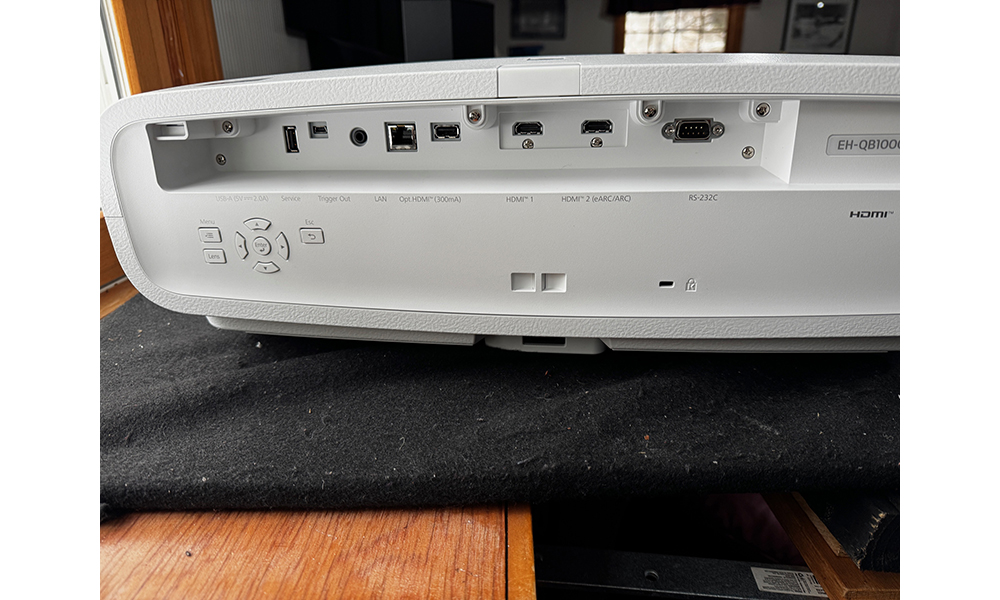For years Epson has been one of the smart home industry’s most popular projector manufacturers with products like LS11000 and the EX11000. Looking to maintain its position as a go-to projector company the company pulled out all the stops during its CEDIA Expo 2024 show activities. Highlighting those activities, the company launched a trio of new projectors last August: The QB1000, the QL3000, and the top-of-the-line QL7000 models.
Designed to provide high levels of performance for modern home video reproduction, the three projectors can be used by dealers to meet a range of multipurpose and dedicated home theater applications.
Trying the most affordable of the three new projectors out for myself, Epson sent me the $7,999 QB1000 to try in my home theater.
CE Pros and Cons
Pros:
- Fantastic image quality with pictures that rival more expensive solutions
- Accurate colors, good image depth, nice levels of compatibility with HDR, live sports and other types of content
- The QB1000 also offers a host of features, and the projector is bright enough to reside in a range of home environments
Cons:
- The projector could be a little easier to setup from its initial setup
Epson QB1000 Features
Utilizing a chassis and industrial design that should be familiar to authorized Epson dealers and video enthusiasts, the entry-level Q Series product is a multi-array laser-based projector that produces 8.29 million pixels to meet the UHD 4K specification.
Through this laser light engine and the company’s 3LCD chipset the QB1000 is rated to produce up to 3,300 lumens of color brightness and white brightness. The projector also utilizes the Epson’s QZX Picture Processor, as well as 120Hz processing, and the company’s UltraBlack technology, which the company describes as a compensation filter that controls the polarization of light.

Other features the QB1000 projector offers integrators, and their clients include a native 120Hz refresh rate, motorized lens shift options, a pair of HDMI 2.1 inputs with ARC/eARC, and ALLM. The projector also features 10-bit HDR for the playback of HDR10, HDR10+, and HLG (Hybrid Log Gamma) high dynamic range (HDR) content, and a 15-element glass lens system.
Additional Features
- 4K projector utilizes Epson’s proprietary 3LCD chip technologies
- The QB1000 incorporates the Epson QZX Picture Processor
- Through a laser light engine, Epson rates the projector to produce 3,300 lumens of brightness
- The projector provides 10-bit HDR color processing to enable it to reproduce HDR, HDR10+ and HLG HDR content
- Retail price of the QB1000 is $7,999
Setup and Installation
Lifting the Epson QB1000 from its box and onto my projector shelf was not a big deal. Epson states the 28-pound projector measures about 7.5 inches tall x 17.5 inches deep and just over 20 inches wide and it fit nicely into my room.
Next, I ran a FBBR fiber-optic HDMI cable from my Integra AVR to the projector and I then connected an AudioQuest power cable. After adding a pair of “AA” batteries to the QB1000’s remote control I was ready to turn the projector on.
Image Alignment & Callibration
Powering the projector up with the remote I pressed the lens button in the center of the remote and after several more attempts to align the projector with my 100-inch Screen Innovations (SI) Pure White 1.3 matte white Zero Edge screen, which is approximately 12 feet from the projector, I gave up and white to the Quick Startup
The guide told me to hit the Lens button for focus, then to hit it a second time for zoom, and then again for the lens shift options. Initially that did not work, but once I figured out that I needed to hit the lens button, and then the “enter” button I was good to go.
Once I got the image aligned and focus using the remote, I entered the QB1000’s menu system, which looks and feels like past Epson menu systems. Setting a few operational parameters, including the selection of the “natural” color mode, as well as the source as HDMI; I turned image enhancement off, and I selected the “auto” aspect ratio mode.

Additionally, I left the projector’s other settings alone, until I later did my calibration adjustments. I felt straight from the box I could easily live with the default settings, but once I adjusted the contrast, black levels and the color parameters, the QB1000’s image quality went from good to great.
Performance
Over the past several years projector companies have upped the ante in terms of out of the box performance. Epson falls into this category, but just as any expert would tell you, there are differences to be made by simply adjusting basic settings such as contrast and black level.
This is one area I thought the QB1000 excelled. Out of the box the projector provided nice images, but just taking the couple of minutes to adjust the contrast and black levels to match my room environment increased elements such as image depth to levels someone would not expect from a projector that falls under the $10,000 plateau. Color looked great out of the box, and I fine-tuned it, so between to the black and contrast level adjustments and the tweaks I made to the color, I was blown away at the overall image quality the QB1000 produced.
Watching streaming services such as Max and its Expedition Unknown, as well as Foxes’ Alert: Missing Persons Unit on Hulu I thought the images were clear with inky, textured colors, and the streaming video displayed a nice dynamic balance.
Using physical media, I popped in the UHD disc Bohemian Rhapsody into my Panasonic UHD disc player to check out HDR10 and HDR10+ content. I was also impressed with this content. Image dynamics seemed to pop, I thought the grayscale tracked well to reveal low-level detail, and getting back to the image depth point, I thought the projector delivered an amazing level of image depth.
Later, I’ll add that I would go into the QB1000’s menu system and set the “frame interpolation” to low to eliminate a bit of judder I had noticed with some content.
Getting back to more physical media I popped in the UHD disc of Godzilla: King of Monsters to view more HDR content and in particular the movie’s many dimly lit scenes. Watching this movie like the streaming content, broadcast television, and physical media, I was once again impressed with the QB1000’s color accuracy, image processing and image depth.
Concluding my viewing activities, I watched a Blu-ray disc version of Blade Runner 2049, and I thought the movie looked exceptional like everything else displaying the HD movie in an upscaled UHD (3840 x2160) resolution.
Final Thoughts on the QB1000
To be completely honest, I was expecting a nice experience with the QB1000. I had seen the projector at CEDIA Expo 2024, along with the more expensive new QL products. Moreover, having owned Epson projection products myself, I had expectations of how the projector would run over an extended period, but the QB1000 blew away my expectations.
Looking at the home projector market as it is currently constituted I would strongly recommend to anyone considering any of the projectors around the $5,000 price to consider stepping up in price and checking out the $8,000 Epson QB1000.
The Epson’s combination of rich, accurate colors, dynamics, including HDR, image clarity, image depth, low-level detail and overall image brightness make for a compelling projector solution that won’t disappoint.
I can’t recommend the QB100 enough.








